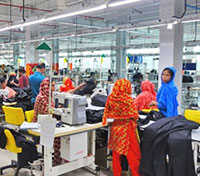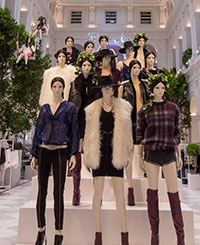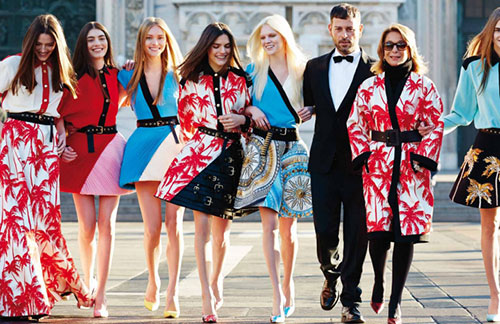FW
 Saurabh Patel, the Energy Minister of Gujarat inaugurated ITMACH India 2019 on December 5, 2019. The textile technology show is being hosted in Gandhinagar’s Helipad Exhibition Centre from December 05-08, 2019.
Saurabh Patel, the Energy Minister of Gujarat inaugurated ITMACH India 2019 on December 5, 2019. The textile technology show is being hosted in Gandhinagar’s Helipad Exhibition Centre from December 05-08, 2019.
The exhibition, organised by K & D ITMACH Expositions, helps the industry to adopt modern technology. The show offers an effective networking and business-matching platform to the industry.
According to Arvind Semlani, Director, K & D ITMACH Expositions, “The Indian textile industry has continuously invested in innovations and technology up-gradations as global opportunities open up. While the spinning sector is facing a challenging situation due to US-China trade war, it has also brought some new opportunities to weaving, knitting, dyeing, printing & wet processing and garment sectors. Global brands and retailers are looking for Indian suppliers with economy of scale plant with state-of-the-art process technology. Therefore, the Indian weaving, processing and garmenting sectors are still in investment mode and resource efficient technologies are much in demand.”
Patel visited several stalls at the show and encouraged entrepreneurs for their efforts. He was impressed by Picanol’s latest weaving machinery - AirjetOmniplus- i loom with Smartshed which is being demonstrated live with denim fabric and operates at production speed above 1000 rpm! P Kasiviswanathan, Director, Picanol explained the innovative features of this latest weaving machine, which is most suited to the Indian weaving sector.
He also visited the booth of India’s leading digital printing solutions company Stovec, Jay Instruments, True Colors, Reckon India,Rimtex,Itema Weaving, Staubli, Texfab among others.
"With the US increasing tariffs on Chinese goods to 25 per cent, Bangladesh’s overseas sales rose to a record $40.5 billion in the year ended June 30.The country now aims to double its exports to $72 billion by 2024. This includes the $41 billion clothing business that goes to China that will provide a fillip to its economy"
 The US-China trade war is creating new export opportunities for other South Asian nations like Bangladesh, Vietnam and Malaysia. For example, Bangladesh-based garment manufacturers like the Newage Group are getting inquiries from US retailers like Macy’s and Gap. Viyellatex Group forecasts its annual exports to the US to more than double to $25 million in the year that began July 1, 2019. About 30 per cent of the company’s clients, including PVH Corp, owner of American fashion labels Tommy Hilfiger and Calvin Klein from the US.
The US-China trade war is creating new export opportunities for other South Asian nations like Bangladesh, Vietnam and Malaysia. For example, Bangladesh-based garment manufacturers like the Newage Group are getting inquiries from US retailers like Macy’s and Gap. Viyellatex Group forecasts its annual exports to the US to more than double to $25 million in the year that began July 1, 2019. About 30 per cent of the company’s clients, including PVH Corp, owner of American fashion labels Tommy Hilfiger and Calvin Klein from the US.
With the US increasing tariffs on Chinese goods to 25 per cent, Bangladesh’s overseas sales rose to a record $40.5 billion in the year ended June 30.The country now aims to double its exports to $72 billion by 2024. This includes the $41 billion clothing business that goes to China that will provide a fillip to its economy.
An opportunity for Bangladesh and Vietnam
So far, Trump has not included finished clothing in the list of tariffs levied on Chinese products. However, if these tariffs are included in the next round, they will impact the Chinese textile industry badly. In a situation like this, Bangladesh and Vietnam will be obvious choices as the next manufacturing destinations as retailers with exposure to the US will move their production out of China. To tap rising demand, Newage has tied up with a Chinese investor to set up a $20 million garment factory in Kaliakoir on the outskirts of the capital Dhaka. The unit will start production in four months.
Infrastructure bottlenecks
However, there are several roadblocks for Bangladesh companies in winning orders from Western firms. Not only does the country need to improve its supply chain, but also modernise its garment factories build highways and reduce red tape at ports to lure more buyers. The central government has been initiating several infrastructure projects. It opened two four-lane bridges on the highway to the Chittagong Port in May and another bridge earlier in March, which reduced travel time to the nation’s main port by almost half. Though the government has also been accelerating highway construction, it still takes 168 hours for exporters in the nation to ship from Dhaka, while it takes just 23 hours in Shanghai.
According to Fahmida Khatun, executive director of Dhaka-based Centre for Policy Dialogue, Bangladeshi exporters also need to improve their productivity for which they need to go for technological upgrade and automation in the garment industry.
Elleti has joined forces with MYR to digitise the creative process and connect users, suppliers and final consumers through a digital platform. Starting from a selection of bold designs, entirely envisioned and developed with MYR software, Elleti worked to recreate its look and fit on six garments, manufacturing each piece according to its signature innovative and responsible approach. Featuring forefront machinery and cutting-edge processing solutions, this relies on a continuous research effort focused on granting high-quality products while increasingly reducing their knock-on effect on both workers and the environment. The result turns out to be very impactful and inspiring, with denim solutions which proved the mastery of the leading Italian company in the art of washing, cutting and stitching the iconic blue fabric, as well as the great support that MYR software provided in the development of the collections.
Highly specialised in laundry and garment-making services, Elleti offers a complete range of services that covers the entire denim production cycle, starting from the development phase consultancy to the finished product. Research, innovation and quality define a unique approach, with a strong focus on sustainability. The group is a point of reference for Europe and the Mediterranean area, based on eleven production plants located between Italy, Tunisia and Romania and a production capacity of 14 million garments per year.
Ethiopia is building up its potential to become the next textile and apparel supply base for the world. Ethiopia may be able to develop the sector more quickly than other countries have in the past because of technological advancement and lesson learning. Despite challenges like an erratic energy supply, cumbersome customs procedures, lack of backward linkages and insufficient skills, Ethiopia hopes to be one of the next textile manufacturing hubs of the world with its wide and young labor pool, growing market potential, advantageous trade agreements, and strategic position.
The country has set up an institute to strengthen the overall value chain and created a conducive investment climate for the sector. The country wants investment that generates inclusive growth without generating irreversible destruction to the environment and resulting in unsustainable development. A handbook guides investors on how to incorporate sustainable practices into their investment journey. It gives concrete guidance on which social and environmental regulations investors need to comply with, where to seek support and which additional sustainability measures can be implemented.
Chinese investment in Ethiopia makes up 60 per cent of the overall FDI in the country. Chinese investment has contributed to the growth of the sector through knowledge and technology transfer, closing local companies’ capital gap and opening up new markets.
The European driving apparel market is growing at a CAGR of 5.7 per cent. Stringent regulations to ensure improved road safety have been a primary driver of the market. The alarming rise in cases of road accidents has compelled countries to enforce stringer regulations. These would encourage the use of various protection gears, which in turn will boost the driving apparel market in Europe.
The driving apparel market in Europe has a highly fragmented vendor landscape. The top three companies in hold barely 27.4 per cent share of the market. This is indicative of the presence of several companies. Investment in product innovation is therefore considered a key strategy by market players to gain improved traction. Companies have aligned their strategies with technological shifts to continue offering robust solutions to their customers. Mergers and acquisitions are widely followed. Strategic collaborations are the most sought after as these allow companies to expand their product portfolio as well as their regional footprint.
By product type, protection gear has the maximum demand and has a 51.7 percent share of the European market in 2016. Based on vehicle type, the two-wheeler segment has a share of 52.5 per cent in the overall market. Germany has a 35.3 per cent share of the overall European driving apparel market.
Mango has set up a new logistics center in Spain. Approximately 600 people work six days a week at the highly automated facility, where around 400 operations are machine-driven, to process items for store deliveries. The 186,000 square meter facility can stock up to seven million hung garments and 20 million folded garments and accessories at the same time. By incorporating the latest automation technologies, the center can process 75,000 garments an hour. As soon as hung garments arrive at the facility they are unloaded onto one of nine automatic loading bays, which can process 27,000 garments an hour. Each bay is equipped with a classifier that separates the garments by size and style. They then travel along a 24-kilometer rail to be shipped out to stores or held in the warehouse. Mango’s hanging garment installation is one of the most automated in Europe.
On the opposite side of the logistics center are automatic loading docks that can process 1,000 boxes of folded garments and accessories an hour. The boxes are passed through a weighing and labeling area and identified with a tracking ID so they can be located at any time. Like the hung garment area, the folded garment warehouse prepares boxes to be either shipped or stored based on in-store sales information.
The Spanish fashion brand with digital transformation and data wants to deliver meaningful changes.
Hugo Boss is bolstering its online business. These efforts have not been in vain - the company’s global online sales in the final quarter of 2018 were up by double digits. Three-quarters of the marketing budget in the coming years will go to digital marketing and a key focus would be on expanding the company's presence in the relevant social networks. Hugo Boss is looking to quadruple last year’s e-commerce sales by 2022.
The German luxury fashion house is strongly committed to the Chinese market. China is a key driver of the company’s growth. The brand’s stores in major cities such as Beijing and Shanghai have been posting double-digit growth throughout the year. Some of the key factors behind Hugo Boss’ emphatic growth in China are its focus on integrating its digital and physical retail channels, increasing its presence on social media as well as partnering brands that resonate with the Chinese audience. While the brand’s high-end casual wear has traditionally been the most popular among Chinese consumers, there has been strong growth in the sales of formal wear, particularly Hugo Boss’ made-to-measure suits. When it comes to made-to-measure offerings, China accounts for more than 50 per cent of the brand’s global sales.
Vinted Europe’s largest online C2C marketplace for secondhand fashion has made it a mission to make secondhand fashion the first choice worldwide. The aim is to make secondhand fashion the first choice worldwide. It has 25 million members across 11 markets in Europe and currently has over 180 million secondhand fashion items listed for sale. It has gone in for a round of funding which will be used to invest in product development and to accelerate Vinted’s rapid growth across Europe. It will enable the company to double headcount in the product and technology teams, invest in technologies to continue to improve the value proposition for members, further strengthen trust, safety, and member-support services on the platform, and continue to grow and connect its strong pan-European member base.
An inflexion point has been reached in the market for secondhand fashion. Consumers around the world are becoming increasingly conscious of their buying choices. Resale platforms, also called consignment sellers, are seeing a high level of consumer engagement. In addition brands have started to realize that consignment players are helping extend the discovery, reach, and appeal of their brands. An item with a strong resale value is seen as strengthening the brand as a whole. The resale market is an excellent way to create a circular economy and reduce the environmental impact.
Anant Ahuja, Managing Director, Shahi Exports
 Based in India, Shahi Exports is a large garment manufacturer. “We have 60 factories across ten states and a workforce of over lakh employees,” notes Anant Ahuja, Managing Director of the company.
Based in India, Shahi Exports is a large garment manufacturer. “We have 60 factories across ten states and a workforce of over lakh employees,” notes Anant Ahuja, Managing Director of the company.
The company is slowly learning about circularity. “We are experimenting with a lot of different ideas through our partnerships with brands as well as others.” Through these partnerships the company hopes to arrive at solutions that are sustainable, circular and economically viable. “Our goal is to convert this textile waste into fuel,” adds Ahuja.
According to Ahuja, brands need to find innovative ways to upcycle garments. “For this, we need to look at large scale solutions. A lot of large brands have made commitments to use 100 percent sustainable materials. This includes using post consumer recycled yarn. The cradle to cradle version of circularity makes this possible. However, its up to us to achieve this,” adds Ahuja.
"The United Nations recently declared an 11-year deadline to prevent irreversible damage from climate change. UK-based NGO Fashion Revolution has launched a Black Friday campaign that encouraged people to protest against mindless consumption and retailers to abstain from providing discounts. Similarly, Extinction Rebellion organized a series of peaceful protests across the world"
 Though the current climate and ecological crisis has made consumers aware of the perils of overproduction and overconsumption of apparels, their consumption habits have undergone some change. This can be noted from the fact that last year Americans spent 25 per cent more on online sales on Black Friday, while Cyber Monday became the largest online shopping event of all times reaching revenues of over $7.9 billion.
Though the current climate and ecological crisis has made consumers aware of the perils of overproduction and overconsumption of apparels, their consumption habits have undergone some change. This can be noted from the fact that last year Americans spent 25 per cent more on online sales on Black Friday, while Cyber Monday became the largest online shopping event of all times reaching revenues of over $7.9 billion.
Protesting against mindless consumption
The United Nations recently declared an 11-year deadline to prevent irreversible damage from climate change. UK-based NGO Fashion Revolution has launched a Black Friday campaign that encouraged people to protest against mindless consumption and retailers to abstain from providing discounts. Similarly, Extinction Rebellion organized a series of peaceful protests across the world. They asked fellow activists in New York to join their ‘Buy Nothing Day Whirl’ movement where people push their empty shopping carts through a store in a lengthy chain of ‘nonshoppers’ followed by meditation outside the New York Public Library.
As a part of their ‘Take Back Black Friday Campaign’, Eco Age and Global Fashion Exchange provided their customers toolkits to share facts and encourage a digital protest. Though this movement started in the US, it has gathered momentum in UK too.
Brands too join the movement 
UK-based fashion brand Raeburn launched a new campaign titled ‘Buy Nothing, Repair Something’ while designer and founder Christopher Raeburn closed both his East London stores and e-commerce section of his website to protest against Black Friday. This boycott is spreading to local European brands as well with Ukrainian brand Ksenia Schnaider planting 10 trees, through Team Trees, for every order during Black Friday weekend.
Patagonia encouraged customers to donate some money to an environmental NGO while beauty company Deciem closed all stores on Friday, November 29 besides shutting down its website for the entire day. Everlane also relaunched its Black Friday Fund through which it donated $10 from every order (up to $300,000) to help put an end to single-use plastic.
Promoting circularity
With these organisations and brands boycotting Black Friday and Cyber Monday, there seems to be a growing awareness of how overconsumption contributes to the climate crisis. However, this awareness does not match last year’s increase in sales over the previous Black Friday weekend. A 2019 Pulse of the Fashion Industry report by Global Fashion Agency, fashion production is projected to rise 81 per cent by 2030. We therefore, need to rethink our relationship with our overall purchasing pattern and instead focus on a consumption model that promotes circularity of clothing and other products.
Brands need to take the end responsibility of the clothes they produce. Consumers also need to remember that their urge to buy something new comes at a heavy cost for the planet. To prevent this, they need to apply a brake on their consumption.












